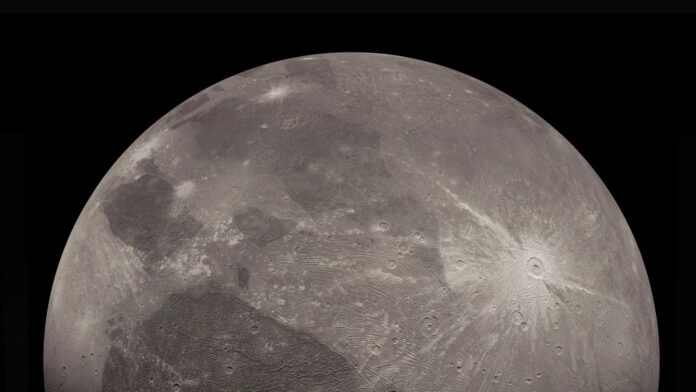Variations in composition throughout Ganymede’s surface reflect the disparities in geological age between the bright and dark regions. Water ice and non-ice material have been found by Galileo and Earth-based telescope observations, which suggests that endogenic or exogenic processes, or a combination of both, are at work. Nevertheless, the spatial resolution obtained by these data needed to be revised to disclose the surface composition on a local level.
A new study presents the high-spatial-resolution infrared spectra of Ganymede observed with NASA’s Juno.
On the surface of Ganymede, Jupiter’s moon, organic molecules, and mineral salts have been detected by NASA‘s Juno mission. The spacecraft’s Jovian InfraRed Auroral Mapper (JIRAM) spectrometer gathered the data for this discovery during a close flyby of the icy moon. The findings may provide scientists with a better understanding of Ganymede’s formation and the makeup of its deep ocean.
Previous spectroscopic measurements by the Very Large Telescope of the European Southern Observatory, NASA’s Galileo spacecraft, and the Hubble Space Telescope suggested the existence of salts and organics. Still, the spatial resolution of those data was insufficient to draw a firm conclusion.
Juno passed over Ganymede on June 7, 2021, at a minimum height of 650 miles (1,046 kilometers). The JIRAM sensor captured infrared pictures and infrared spectra of the moon’s surface shortly after the point of closest approach.
More than 0.62 miles (1 kilometer) per pixel was the exceptional spatial resolution for infrared spectroscopy collected from Ganymede’s JIRAM data during the flyby. It allowed Juno scientists to identify and examine the distinct spectrum characteristics of molecules other than water ice, such as sodium bicarbonate, hydrated sodium chloride, ammonium chloride, and aliphatic aldehydes.
Federico Tosi, a Juno co-investigator from Italy’s National Institute for Astrophysics in Rome and lead author of the paper, said, “The presence of ammoniated salts suggests that Ganymede may have accumulated materials cold enough to condense ammonia during its formation. The carbonate salts could be remnants of carbon dioxide-rich ices.”
The moon’s equatorial portion is protected from Jupiter’s intense magnetic field from powerful electron and heavy ion bombardment up to a latitude of roughly 40 degrees, according to earlier modeling of Ganymede’s magnetic field. It is commonly recognized that the existence of these particle fluxes has a detrimental effect on organics and salts.
JIRAM’s flyby in June 2021 encompassed a limited range of latitudes in the Jupiter-facing hemisphere (10 degrees north to 30 degrees north) and a wider range of longitudes (minus 35 degrees east to 40 degrees east).
Scott Bolton, Juno’s principal investigator from the Southwest Research Institute in San Antonio, said, “We found the greatest abundance of salts and organics in the dark and bright terrains at latitudes protected by the magnetic field. This suggests we are seeing the remnants of a deep ocean brine that reached the surface of this frozen world.”
Journal Reference:
- Tosi, F., Mura, A., Cofano, A. et al. Salts and organics on Ganymede’s surface observed by the JIRAM spectrometer onboard Juno. Nat Astron (2023). DOI: 10.1038/s41550-023-02107-5
